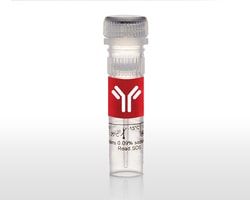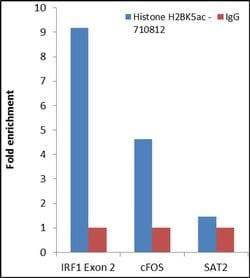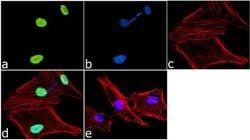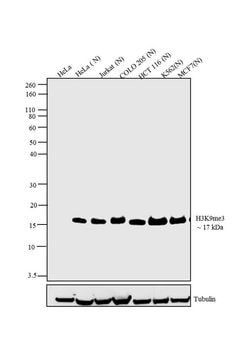H4K20ac Recombinant Polyclonal Antibody (2HCLC), Invitrogen™
Manufacturer: Thermo Scientific
Select a Size
| Pack Size | SKU | Availability | Price |
|---|---|---|---|
| Each of 1 | PI710810-Each-of-1 | In Stock | ₹ 54,112.00 |
PI710810 - Each of 1
In Stock
Quantity
1
Base Price: ₹ 54,112.00
GST (18%): ₹ 9,740.16
Total Price: ₹ 63,852.16
Antigen
H4K20ac
Classification
Recombinant Polyclonal
Concentration
0.5 mg/mL
Formulation
PBS with 0.09% sodium azide; pH 7.2
Gene Accession No.
P62805
Gene Symbols
HIST1H4A
Immunogen
Acetylated peptide (Lys20) corresponding to human Histone H4 (aa 18-26)
Quantity
100 μg
Primary or Secondary
Primary
Target Species
Human
Product Type
Antibody
Isotype
IgG
Applications
Immunocytochemistry, Peptide Array, Western Blot
Clone
2HCLC
Conjugate
Unconjugated
Gene
HIST1H4A
Gene Alias
acetyl Histone H4; Acetyl-H4 K20; Acetyl-H4 Lys20; Acetyl-Histone H4 K20; Acetyl-Histone H4 Lys20; FO108; H4; H4 histone family, member A; H4 histone family, member I; H4 histone family, member J; H4 histone family, member M; H4 histone family, member N; H4 histone, family 2; H4 K20ac; H4/A; H4/B; H4/C; H4/D; H4/E; H4/G; H4/H; H4/I; H4/j; H4/K; H4/M; H4/n; H4/O; H4/p; H4-16; H4C1; H4C11; H4C12; H4C13; H4C14; H4C15; H4C2; H4C3; H4C4; H4C5; H4C6; H4C8; H4C9; H4F2; H4FA; H4FB; H4FC; H4FD; H4FE; H4FG; H4FH; H4FI; H4FJ; H4FK; H4FM; H4FN; H4FO; H4K20; H4K20a; H4Lys20ac; H4M; HIST1H4; HIST1H4A; HIST1H4B; HIST1H4C; HIST1H4D; HIST1H4E; HIST1H4F; HIST1H4H; HIST1H4I; HIST1H4J; HIST1H4K; HIST1H4L; HIST2H4; HIST2H4A; HIST2H4B; HIST4H4; histone 1, H4a; histone 1, H4b; histone 1, H4e; histone 1, H4i; histone 2, H4a; Histone 4; Histone 4 family, member M; histone 4, H4; histone cluster 1, H4a; histone cluster 1, H4b; histone cluster 1, H4e; histone cluster 1, H4i; histone cluster 2, H4a; Histone Clust
Host Species
Rabbit
Purification Method
Protein A
Regulatory Status
RUO
Gene ID (Entrez)
8359
Content And Storage
Store at 4°C short term. For long term storage, store at -20°C, avoiding freeze/thaw cycles.
Form
Liquid
Description
- Recombinant rabbit polyclonal antibodies are unique offerings from Thermo Fisher Scientific
- They are comprised of a selection of multiple different recombinant monoclonal antibodies, providing the best of both worlds - the sensitivity of polyclonal antibodies with the specificity of monoclonal antibodies - all delivered with the consistency only found in a recombinant antibody
- While functionally the same as a polyclonal antibody - recognizing multiple epitope sites on the target and producing higher detection sensitivity for low abundance targets - a recombinant rabbit polyclonal antibody has a known mixture of light and heavy chains
- The exact population can be produced in every lot, circumventing the biological variability typically associated with polyclonal antibody production
- H4K20ac Recombinant Polyclonal antibody specifically detects H4K20ac in Human samples
- It is validated for Immunocytochemistry, Peptide Array, Western Blot.











